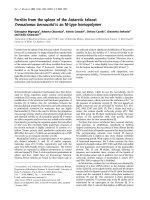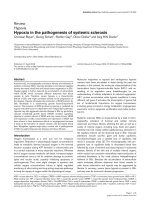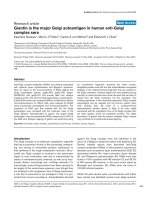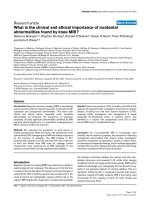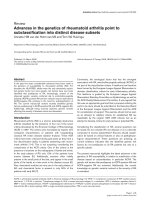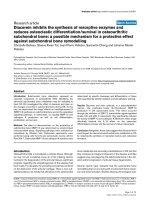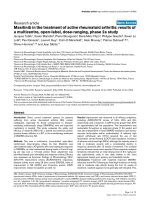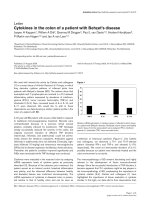Báo cáo y học: "Where is the difference between the genomes of humans and annelids" pot
Bạn đang xem bản rút gọn của tài liệu. Xem và tải ngay bản đầy đủ của tài liệu tại đây (57.21 KB, 2 trang )
Genome Biology 2006, 7:203
comment
reviews
reports deposited research
interactions
information
refereed research
Minireview
Where is the difference between the genomes of humans and
annelids?
Alexei Fedorov*
†
and Larisa Fedorova*
Addresses: *Department of Medicine and
†
Program in Bioinformatics and Proteomics/Genomics, Medical University of Ohio, Toledo,
OH 43614, USA.
Correspondence: Alexei Fedorov. Email:
Abstract
The first systematic investigation of an annelid genome has revealed that the genes of the marine
worm Platynereis dumerilii are more closely related to those of vertebrates than to those of
insects or nematodes. For hundreds of millions of years vertebrates have preserved exon-intron
structures descended from their last common ancestor with the annelids.
Published: 1 February 2006
Genome Biology 2006, 7:203 (doi:10.1186/gb-2006-7-1-203)
The electronic version of this article is the complete one and can be
found online at />© 2006 BioMed Central Ltd
Among the millions of invertebrate species, the genomes of
insects (particularly fruit flies of the genus Drosophila) and
nematodes (from the genus Caenorhabditis) have come
under the closest scrutiny. Now it is time for annelids - the
segmented worms - to reveal their DNA sequences and gene
structures. Last November, Raible and co-authors reported
in Science the initial investigation of 30 genes from the
marine annelid Platynereis dumerilii [1]. And it revealed a
big surprise. The sequences of the annelid proteins were
found to be more closely related to their human orthologs
than to the insect and nematode orthologs. Moreover,
among the species compared, the exon-intron structure of
P. dumerilii genes was also most similar to that of humans:
the human and the marine worm genomes have the highest
number of introns per gene (7.8 for annelid and 8.4 for
human and other mammalian genes) and more than 60% of
annelid introns divide protein-coding sequences at exactly
the same positions as human introns. By comparison,
insects have 2.4 to 5.4 introns per gene and the plant repre-
sentative Arabidopsis thaliana has 4.4, whereas fungi have
the broadest spread from 0.0075 to 6.8 [2]. Thus, as far as
shared introns are concerned, P. dumerilii is more similar to
humans than to any insect or nematode.
The similarities in intron numbers and positions between
P. dumerilii and humans does not imply that annelids
should be combined with the vertebrates into a sister clade
and distanced from nematodes and insects. Despite known
uncertainties in the exact positioning of the segmented
worms on the animal evolution tree (reviewed in [3]), nobody
has ever grouped annelids with vertebrates. Molecular evolu-
tion is an intricate nonlinear process that can be interpreted
in many different ways and it cannot be inferred from a set
of equations. Conflicting facts and opposing opinions are
common in the field and several alternative phylogenetic
trees have been proposed for the animal kingdom. In their
short article, Raible et al. [1] present only one animal phy-
logeny, whereas a subsequent comment by Kumar and
Hedges [4] in Cell points out other well-recognized possible
alternative relationships between flies, worms and humans.
There has been a long and fierce debate about the phyloge-
netic relationships between arthropods, nematodes and ver-
tebrates [5]. The ‘Ecdysozoa hypothesis’ groups arthropods
and nematodes into a monophyletic clade and distances
them from the vertebrates. The alternative ‘Coelomata
hypothesis’ considers arthropods to be more closely related
to the vertebrates than to the nematodes. We are still very far
from resolving this dilemma. Even the whole-genome phylo-
genetic analyses of Drosophila, Caenorhabditis elegans and
humans have not brought much clarity because, depending
on the algorithms used, support can be found for both the
Coelomata hypothesis [6] and the Ecdysozoa hypothesis [7].
Undoubtedly, the results in the Science article by Raible et
al. [1] will serve as important additional, yet non-decisive,
evidence in these endless debates on the origin of species.
The new data of Raible et al. [1] further complicate our per-
ception of evolution. We used to think that humans have sig-
nificantly advanced in complexity compared to the various
worm phyla. It is, however, unclear where this complexity is
encoded within our genome. Homo sapiens has only 21%
more protein-coding genes than the microscopic nematode
worm Caenorhabditis elegans, whose entire neural system is
composed of 300 neurons [8]. Moreover, Raible et al. [1]
have now shown that evolutionary changes in human
protein sequences have occurred more slowly than in insects
and nematodes. Thus, our proteins cannot be superior to
those of invertebrates. Many biologists used to think that
vertebrates had perfected their gene structures by acquiring
thousands of new introns which, in turn, increased their
protein diversity via alternative splicing. Yet according to
Raible et al., the last common ancestor between vertebrates
and annelids had nearly as many introns as humans. So,
evolution has hardly affected the gene structure of the verte-
brate lineage.
The last line of defense in our ambition for pre-eminence is
the total size of our genomes. Indeed, the human haploid
genome contains more than 3 billion nucleotides, or 3.5
picograms (pg) of DNA. According to the Animal Genome
Size Database [9] this is several times more than the haploid
genome size of the vast majority of invertebrates, including
Drosophila melanogaster (0.18 pg), C. elegans (0.10 pg), and
P. dumerilii (0.89 pg). There are, however, many exceptions
to the correlation between an organism’s morphological and
functional complexity and the absolute size of its genome.
Some invertebrates have a genome size comparable to that of
humans [10,11]. The well-known example of the unicellular
Amoeba dubia, with a genome 200 times larger than that of
humans [9], demonstrates that mere DNA length does not
determine an organism’s complexity. The major fraction of
an animal genome is represented by non-protein-coding
sequences: for humans, the noncoding regions comprise
98.5% of the genome. For years, noncoding DNA (including
introns) was largely ignored and was frequently referred to as
‘junk’ or ‘selfish’ DNA. But only a few years ago it became
generally appreciated that three quarters of our genome is
transcriptionally active and produces at least 16,000 non-
protein-coding RNAs, many of which have important cellular
functions [12,13]. Nevertheless, a considerable fraction of
transcribed noncoding RNA from species with extra-large
genomes probably represents random transcripts without
any valuable role for the organism [14]. Therefore, organis-
mal complexity cannot be simply determined by the genome
size, the number of protein-coding genes, the number of
introns, or the total number of genomic transcripts. Rather,
we should assess these parameters all together, and estimate
how efficiently a particular species utilizes its genomic
machinery, and the proportion of nonfunctional genomic
ballast to functional elements.
Introns, for example, are ambivalent elements that create
several problems for cells and perform various functions
[15,16]. Jeffares et al. [17] have recently reviewed the process
of intron gain and loss. They and others have demonstrated
that intron evolution is not a simple stochastic process, and
that a number of biological factors have important influ-
ences on change or preservation of exon-intron gene struc-
tures. Despite the fact that marine annelids and humans
have the same number of introns, commonly in the same
positions, the importance of these introns for the host cells
could be different. Right now we only know for sure that
human introns are longer than those of P. dumerilii and
contain hundreds of noncoding RNAs as well as a number of
valuable cellular signals [14]. All in all, introns are not trivial
elements, and the comparison of their positions in different
species is only the first step in understanding their intricate
evolution in animals and other eukaryotic taxa. Biologists
have recently gained access to genomic information from
dozens of eukaryotic and hundreds of prokaryotic species.
This has only brought us to the embryonic stage of genome
biology theory and numerous surprises are to be expected
along the road ahead.
References
1. Raible F, Tessmar-Raible K, Osoegawa K, Wincker P, Jubin C, Bal-
avoine G, Ferrier D, Benes V, de Jong P, Weissenbach J, et al.:
Vertebrate-type intron-rich genes in the marine annelid
Platynereis dumerilii. Science 2005, 310:1325-1326.
2. Nielsen CB, Friedman B, Birren B, Burge CB, Galagan JE: Patterns
of intron gain and loss in fungi. PLoS Biol 2004, 2:e422.
3. McHugh D: Molecular phylogeny of the Annelida. Can J Zool
2000, 78:1873-1884.
4. Kumar S, Hedges SB: Pushing back the expansion of introns in
animal genomes. Cell 2005, 123:1182-1184.
5. Telford MJ: Animal phylogeny: back to the coelomata? Curr
Biol 2004, 14:R274-R276.
6. Wolf YI, Rogozin IB, Koonin EV: Coelomata and not Ecdysozoa:
evidence from genome-wide phylogenetic analysis. Genome
Res 2004, 14:29-36.
7. Dopazo H, Dopazo J: Genome-scale evidence of the nematode-
arthropod clade. Genome Biol 2005, 6:R41.
8. Wormbase
[ />9. Animal Genome Size Database []
10. Gregory TR: Synergy between sequence and size in large-
scale genomics. Nat Rev Genet 2005, 6:699-708.
11. Vinogradov AE: Evolution of the genome size: multilevel
selection, mutation bias or bynamical chaos? Curr Opin Genet
Dev 2004, 14:620-626.
12. Suzuki M, Hayashizaki Y: Mouse-centric comparative transcrip-
tomics of protein coding and non-coding RNAs. BioEssays
2004, 26:833-843.
13. Frith MC, Pheasant M, Mattick JS: The amazing complexity of
the human transcriptome. Eur J Hum Genet 2005, 13:894-897.
14. Fedorova L, Fedorov A: Puzzles of the human genome: why do
we need our introns? Curr Genomics, in press.
15. Lynch M, Richardson AO: The evolution of spliceosomal
introns. Curr Opin Genet Dev 2002, 12:701-710.
16. Rogozin IB, Sverdlov AV, Babenko VN, Koonin, EV: Analysis of
evolution of exon-intron structure of eukaryotic genes. Brief
Bioinform 2005, 6:118-134.
17. Jeffares DC, Mourier T, Penny D: The biology of intron gain and
loss. Trends Genet 2006, 22:16-22.
203.2 Genome Biology 2006, Volume 7, Issue 1, Article 203 Fedorov and Fedorova />Genome Biology 2006, 7:203
